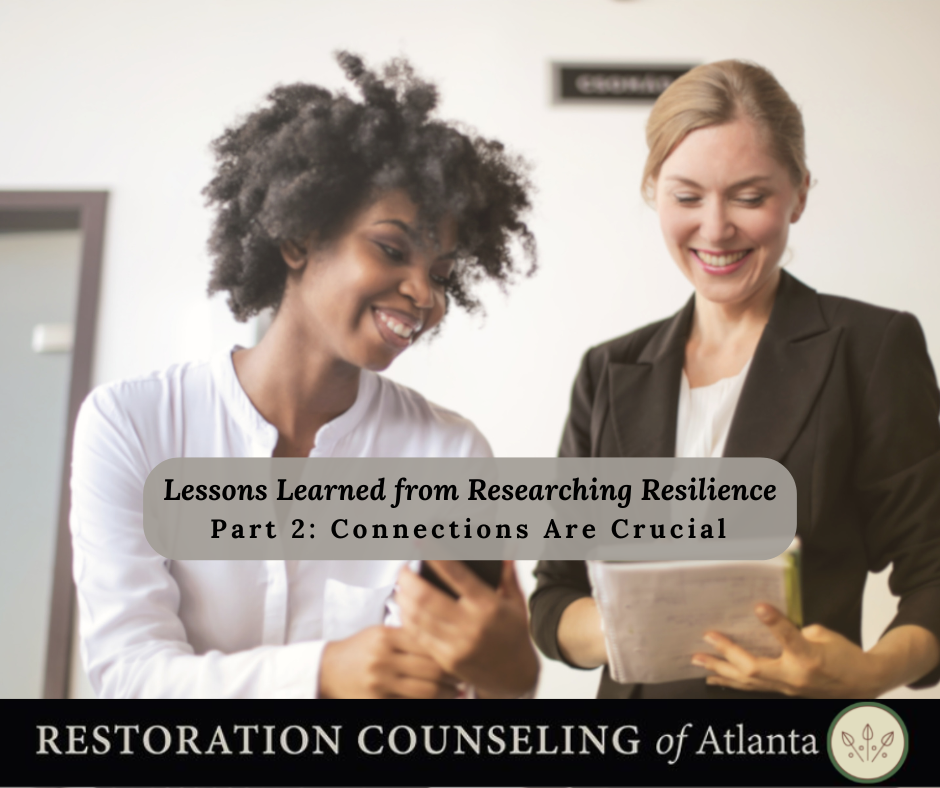Part 2: Connections are Crucial
Welcome to Part 2 in my series, “Lessons Learned from Researching Resilience.” In this series, I share my insights from researching resilience and explain how we can apply these strategies in our daily lives.
Part 2 is titled, “Connections Are Crucial,” because at the heart of resilience lies our connection with other people.
If you already have positive connections with others, you are likely feeling encouraged; however, if your connections with others are not strong, you may have an urge to stop reading. After all, how much control can we really have over feeling connected? It turns out we do have some control, so please read on! I hope to encourage you and provide some simple ways of strengthening this muscle.
The Science of Connecting
In my study, I interviewed trauma therapists and children regarding their thoughts on the contributions of resilience from trauma. The answer universally provided and most discussed was the child’s connections to other people.
The importance of the “other” to resilience was echoed in the hundreds of studies I reviewed, including the 80 year long Harvard study on happiness discussed in the book “The Good Life” by Waldinger and Schutz (2023).
Socialization is THE building block of resilience. This is because we are designed by God to need other humans! When you interact with a person, your brain and body react, and it results in physiological changes.
At the same time, the other person’s brain and body are responding to you. Remember from Part 1, we are always being influenced, AND we are always influencing other people.
Resilience is transactional. This means that resilience is not just about the traits of the individual, but it is equally influenced by the relationships and environment that individual is embedded in.
Risks and Benefits of Social Interaction
When you interact with another person, your brain and body respond. That response can be depleting OR resilience-building.
Many people avoid contact with others because of the misbelief that interaction will be unpleasant, awkward, unnecessary, or even harmful. However, according to multiple research studies, the benefit outweighs the risks!
What Are the Risks?
- Social pain hurts, literally! When we experience social pain, such as being left out, it activates similar brain regions associated with physical pain. Yes, social pain really HURTS!
- The risk of social pain is often cited as a reason for avoiding contact with other people…
- … BUT isolation also hurts. The experience of loneliness is associated with as great a risk to life expectancy as smoking!
How is Social Contact Beneficial?
- Having (imperfectly) supportive relationships are attached to ALL kinds of benefits!
- Relationships are attached to greater longevity, sense of wellbeing, happiness, sense of purpose, life satisfaction, and lower mental and physical health struggles.
- Just holding someone’s hand during a medical procedure lowers the brain and body’s reaction to pain!
- In trauma-specific research, supportive relationships are connected to resilience from natural disasters, bereavement, chronic or terminal illness, sexual abuse/assault, adverse childhood experiences, and first responder and combat experiences.
It turns out resilience points to one thing: our connections with others.
A Comment About Introversion and Extroversion
Our need for social connection is NOT dependent or linked to the personality traits of introversion or extroversion. All people need people, regardless of their personality. Our personality traits of introversion or extroversion, however, can color our social health both positively and negatively.
Extroverts
-
- Benefits of being an extrovert: Extroverts recognize a “need” to socialize more quickly than introverts do. In research, extroverts tend to have elevated levels of resilience because they “self-seek” social connections (even with strangers) without waiting for others to seek them first.
- Risks of being an extrovert: Extroverts are vulnerable to being “lonely in a crowd,” where they have several friends with limited depth of connection. Additionally, extroverts may say a lot while saying nothing about what is really bothering them.
- Lowering the risk for extroverts:
- Recognize that quantity does not always mean quality.
- Work to enhance the depth and sharing of self in your relationships.
- Use time away from others to increase self-reflection and tolerance for alone time.
Introverts
-
- Benefits of being an introvert: Introverts tend to enjoy a smaller number of relationships with greater depth, which can enhance feelings of interpersonal connectedness. They also have fewer negative emotions about spending time alone or having fewer friendships, which can be protective against feelings of loneliness.
- Risks of being an introvert: Isolation can become a comfortable habit, and introverts may ignore their need to connect. Additionally, introverts may dislike superficial social connections like small talk and/or wait for others to initiate social contact, which increases their vulnerability to feeling disconnected.
- Lowering the risk for introverts:
- Initiate social contact instead of waiting for others to initiate. Social contact is important for your health, too; it just looks different!
- Monitor self for feeling too comfortable with isolation or if fear of socialization is creeping in.
- Recognize the benefits of “small talk” and superficial social interactions. Small talk builds greater feelings of trust and liking and increases the number of positive emotions for the giver and receiver.
Research in Practice: How to Enhance Your Connections
- Recognize the natural tendency to withdraw
- Just like we withdraw our hands when in physical pain, humans tend to withdraw from other humans when they experience emotional pain.
- Withdrawal can be helpful; it allows us time to recover, but withdrawal over time makes us “stuck” in withdrawal mode.
- Therefore, allow yourself small periods of recovery that do not last TOO long
- Don’t expect others to reach out
- People may not reach out for MANY reasons– busyness, personal struggles, lack of awareness, lack of knowledge about “how to help,” or fear of not helping in the “right” way can create insecurity around reaching out to others.
- Don’t wait for someone to reach out to you; give them grace because their lack of reaching out is likely about them and not a lack of care for you.
- Conduct “social fitness assessment”
- Just like we take assessments of our physical health and build routines to enhance strength and endurance, we need to assess our social health.
- To intentionally build your social muscles, Waldinger and Schultz (2023) suggest starting by identifying those who make you laugh, whom you enjoy the most, or whom you’d call in a crisis.
- Include significant relationships as well as casual acquaintances. The person you enjoy at your child’s soccer practice is more life-giving than you realize!!
- Next, ask yourself, “how frequently am I with these people? What’s the quality of time like?” “How often do I initiate the contact?”
- Once you have your list, read the tips below to strengthen your skills!
Tips For Strengthening Your Social Fitness
Remember as you strengthen this muscle you are strengthening your RESILIENCE muscle!
- Small steps matter: When socially depleted or socially anxious, engaging with others feels daunting. Ask, “What is the SMALLEST engagement that feels doable?”
- Examples: Text or call one person once a week. Gradually build up to meeting that person for coffee twice a month and eventually join them in a small Bible study.
- Focus on the “win”: you are taking small steps. You may not feel “good” engaging with others at first, but over time– taking very small steps –you will get used to it. THEN you will experience benefit!
- Engage in “micro” social interactions:
- Studies show that purposeful and small social interactions with strangers at the grocery store, in a restaurant, or on a commute to work boost positive emotions which appear to last well beyond that brief interaction (Epley & Schroeder, 2014).
- Examples: Say, “Hi, how is your day?” “I like your shirt,” “Have a good day,” or “Nice weather today” to people you encounter.
- Notice how you “feel” afterwards. Are you smiling? If it felt awkward, that’s okay. It may take time, so keep practicing!!
- Using the internet/social media to connect: Technology may be a blessing or a curse; however, online contact may literally be a life saver for those who are isolated.
- Technology can help us find groups to join that are full of individuals like us.
- Try to use technology “actively”– rather than scrolling, make POSITIVE comments and engage in small online groups.
- Use tech to engage offline. Start with positive comments and lead to texting or meeting in person.
- Notice how you feel. If you experience more negative emotions or too much self-comparison after engagement, it might not be the right setting.
- In-Person: Other forms of connection are good substitutes; however, there is NO connection like in-person connection (even micro connections).
- Our brains and bodies experience benefits more fully when we are in-person than in any other way.
- Help Others: If you are struggling to find social connection, one of the best ways to connect is by helping others.
- There are MULTIPLE benefits to helping others, including elevation of happiness, improved wellbeing, feelings of purpose, and increased social interaction and development of friendships.
- There is no shortage of people who need our help, and there are many ways to help that do not take too much time.
- Start small, matching your strengths and personality.
Note for Parents: Teach children these tips just like you teach other health skills.
- Children need to practice social interaction more now that they are using technology more frequently.
- Think about how much more social connection there is watching TV as a family than individually scrolling through videos.
- Get off your phone and engage in more frequent face-to-face interactions; this builds your child’s social skills and reduces anxiety and depression.
Conclusion
In my personal reflections, I see no better evidence that we were created to need others than in Genesis and the story of creation.
When God created Adam, He stated, “It is not good for man to be alone.” He then created Eve, the first woman, which occurred BEFORE the fall of man; before sin entered the world, Adam had God but still needed another human! Furthermore, when Jesus became man, He chose his disciples to walk with Him. Although Jesus spent time alone in prayer and connection with God, He also connected with others, proving the importance of our relationship with God as well as our relationships with others.
Thanks for reading! I hope these tips provide practical ways for you to build resilience through your connection with others.

Written by Lauren Hamrick, PhD, MS, EdS, LPC, RPT, CPCS
lauren@restorationcounselingatl.com
Roswell Location
Lauren Hamrick is an active, educationally focused therapist who enjoys using both evidence-based and out-of-the-box approaches with children and adults. Lauren is also a registered play therapist. She listens to the interests, knowledge, and experiences of her clients and incorporates them into her therapeutic approaches. Areas of focus include career-related stress, anxiety, PTSD, young adult issues, life transitions, abuse recovery, parenting, and family therapy. Lauren also enjoys working with couples who are dealing with parenting issues or are empty nesters.

